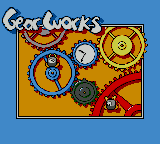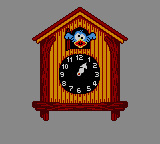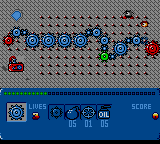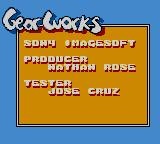Gear Works
From Sega Retro
| Gear Works | ||||||||||
|---|---|---|---|---|---|---|---|---|---|---|
| System(s): Sega Game Gear | ||||||||||
| Publisher: Sony Imagesoft | ||||||||||
| Developer: Teque London | ||||||||||
| Genre: Puzzle | ||||||||||
| Number of players: 1 | ||||||||||
| ||||||||||
|
Gear Works is a puzzle game for the Sega Game Gear. It was only released in North America, although a European release was planned.[3]
Contents
Gameplay
Gear Works is a puzzle game where the player is tasked with rebuilding twelve clocks located in famous monuments throughout the world. To do this, the player must place gears on a grid filled with pegs in order to construct an unbroken train of gears from the rotating gear on the left side of the puzzle to the stationary gear on the right side of the puzzle.
Gears rotate when they are linked together properly. There are three sizes of gears, which can only be linked in specific combinations:
| Combination | Description |
|---|---|
| A medium gear can be connected adjacent to a small gear. | |
| A medium gear can be linked diagonally to another medium gear. | |
| A large gear can be linked diagonally to a small gear. | |
| A large gear can be connected adjacent to another large gear. |
Gears also come in three different colors: blue, green, and orange. Green gears can be connected together for bonus points, and orange gears are rusty and must be oiled to operate smoothly. Gears are given out one at a time with a random size and color, so the current gear may not fit into the chain that the player is building, forcing the player to build out separate segments to connect later. The next gear is shown in a window on the left side of the status area. Adjacent gears spin in opposite directions, and connecting more than two gears together jams them and prevents the mechanism from moving.
The engine becomes hotter as time passes; the engine temperature is indicated by a bar in the status area of the screen and acts as a time limit. Rusty or jammed gears also raise the temperature. Additionally, gremlin-like creatures called poffins appear to wander the grid. There are two types, a smaller one that can rust gears and a larger one that can break off pegs. The player has a toolbox containing tools that can be used a limited number of times per puzzle, including oil that can be used to lubricate rusty gears and a gun that can be used to shoot poffins.
The D-Pad moves a crosshair around the peg grid, ![]() places a gear or uses an item on the selected location, and
places a gear or uses an item on the selected location, and ![]() allows the player to select a tool from the toolbox. The cursor changes to indicate the currently selected tool.
allows the player to select a tool from the toolbox. The cursor changes to indicate the currently selected tool.
After completing a puzzle, the player is given a score, with points added for working gears placed and points subtracted for misplaced or non-working gears. Each of the twelve stages consists of multiple levels, and each level can contain more than one puzzle. The engine temperature is carried over between puzzles on the same level but resets on a new level. The player starts the game with three lives and must restart the current level at the cost of a life if the engine overheats. The game gives the player a password after completing each stage.
Tools
Pressing ![]() opens the toolbox and pressing
opens the toolbox and pressing ![]() uses the current tool. The game starts with 5 uses of each item (aside from placing gears, which has no limit).
uses the current tool. The game starts with 5 uses of each item (aside from placing gears, which has no limit).
| Gear | |
|---|---|
| Places the next gear on the puzzle. The size and color of the gear is chosen randomly. The cursor changes to indicate the size of the current gear. The cursor is usually white but changes to the color of the gear if it will connect to another gear if placed in the selected location. Placing a gear on top of a poffin pops it. | |
| Bomb | |
| Blows up a previously placed gear so that a different gear can be placed on its peg. It also eliminates nearby poffins (but cannot target them directly). | |
| Gun Sight | |
| Shoots a poffin anywhere on the grid. There is a short delay between shooting and the shot landing. | |
| Oil Can | |
| Lubricates a rusty (orange) gear so that it turns freely. |
Passwords
- Main article: Gear Works/Passwords.
Production credits
- Producer: Nathan Rose
- Tester: Jose Cruz
- Olaf Olaffson, Lester Greenman, Peter Dille, Jeff Benjamin
- Programming: Barry Costas, Colin Hughes
- Graphics: Mark Anthony
- Music: Peter Henning
- Producer: Tony Love
Magazine articles
- Main article: Gear Works/Magazine articles.
Promotional material
also published in:
Physical scans
| Sega Retro Average | ||||||||||||||||||||||||
|---|---|---|---|---|---|---|---|---|---|---|---|---|---|---|---|---|---|---|---|---|---|---|---|---|
|
| 69 | |
|---|---|
| Based on 4 reviews | |
Technical information
ROM dump status
| System | Hash | Size | Build Date | Source | Comments | |||||||||
|---|---|---|---|---|---|---|---|---|---|---|---|---|---|---|
| ? |
|
128kB | Cartridge (US) |
References
- ↑ GamePro, "December 1993" (US; 1993-xx-xx), page 247
- ↑ 2.0 2.1 GamePro, "February 1994" (US; 199x-xx-xx), page 152
- ↑ Sega Pro, "December 1993" (UK; 1993-11-11), page 106
- ↑ File:Gear Works GG credits.pdf
- ↑ GamePro, "January 1994" (US; 199x-xx-xx), page 217
- ↑ Game Players, "Vol. 6 No. 10 October 1993" (US; 1993-xx-xx), page 129
- ↑ Megablast, "1/94" (DE; 1993-12-29), page 82
- ↑ Mean Machines Sega, "March 1994" (UK; 1994-01-28), page 66
| Gear Works | |
|---|---|
|
Main page | Comparisons | Maps | Passwords | Hidden content | Magazine articles | Reception | |









